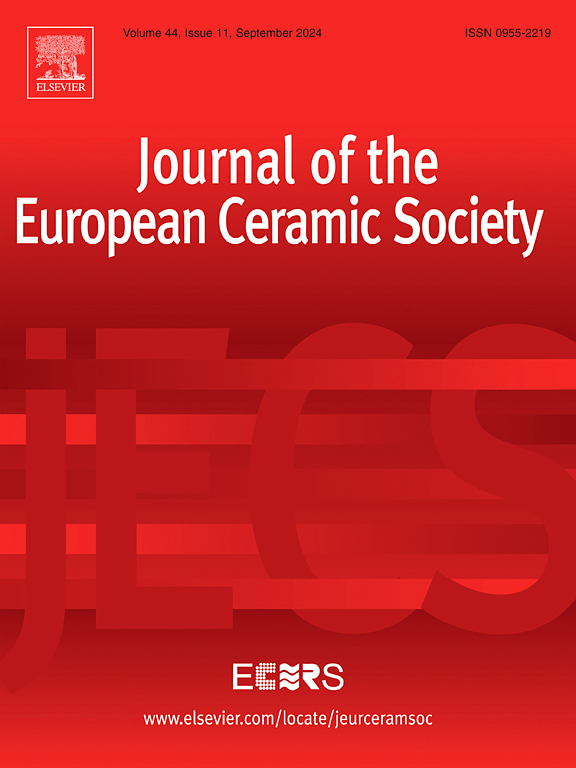Tribological behavior and mechanism of high-temperature self-lubricating wear-resistant composite coatings on 3D-printed SiC ceramic surfaces
IF 5.8
2区 材料科学
Q1 MATERIALS SCIENCE, CERAMICS
Journal of The European Ceramic Society
Pub Date : 2025-04-21
DOI:10.1016/j.jeurceramsoc.2025.117473
引用次数: 0
Abstract
In this paper, high-temperature self-lubricating wear-resistant YSZ-Al2O3-CaF2-C composite coatings were prepared on the surface of 3D-printed SiC ceramics using nano-ZrO2 modification assisted with plasma spraying technology. This study focuses on the tribological behavior and mechanism of the composite coatings between room temperature and 600 °C. From room temperature to 600 °C, the composite coatings' friction coefficients and volumetric wear rates fell between 0.151 and 0.496 and 0.91 × 10−5 and 5.58 × 10−5 mm³ /N·m, respectively. During friction, the self-lubricating effect of C at room temperature and CaF2 at high temperature (above 400 °C) can produce a lubricating film and effectively reduce the friction coefficient of the composite coatings. Microscopic analysis revealed that the primary wear characteristics of the composite coatings are abrasive chips, grooves, and Si transfer layers, demonstrating that the wear mechanisms are abrasive wear and adhesive wear. It indicates that the high-temperature self-lubricating and wear-resistant performance of the YSZ-Al2O3-CaF2-C composite coatings can be significantly improved by designing the material components, which is of great significance for the application of wear-resistant ceramic parts in aerospace industry.
3d打印SiC陶瓷表面高温自润滑耐磨复合涂层的摩擦学行为及机理
本文采用纳米zro2改性辅助等离子喷涂技术,在3d打印SiC陶瓷表面制备了高温自润滑耐磨的YSZ-Al2O3-CaF2-C复合涂层。研究了复合涂层在室温至600℃范围内的摩擦学行为和机理。从室温到600℃,复合涂层的摩擦系数和体积磨损率分别在0.151 ~ 0.496和0.91 × 10−5和5.58 × 10−5 mm³ /N·m之间。摩擦时,室温C和高温(400℃以上)CaF2的自润滑作用可形成润滑膜,有效降低复合涂层的摩擦系数。微观分析表明,复合涂层的主要磨损特征为磨屑、沟槽和Si转移层,表明复合涂层的磨损机制为磨粒磨损和粘着磨损。结果表明,通过对材料组分的设计,可以显著提高YSZ-Al2O3-CaF2-C复合涂层的高温自润滑和耐磨性能,这对耐磨陶瓷件在航空航天工业中的应用具有重要意义。
本文章由计算机程序翻译,如有差异,请以英文原文为准。
求助全文
约1分钟内获得全文
求助全文
来源期刊

Journal of The European Ceramic Society
工程技术-材料科学:硅酸盐
CiteScore
10.70
自引率
12.30%
发文量
863
审稿时长
35 days
期刊介绍:
The Journal of the European Ceramic Society publishes the results of original research and reviews relating to ceramic materials. Papers of either an experimental or theoretical character will be welcomed on a fully international basis. The emphasis is on novel generic science concerning the relationships between processing, microstructure and properties of polycrystalline ceramics consolidated at high temperature. Papers may relate to any of the conventional categories of ceramic: structural, functional, traditional or composite. The central objective is to sustain a high standard of research quality by means of appropriate reviewing procedures.
 求助内容:
求助内容: 应助结果提醒方式:
应助结果提醒方式:


